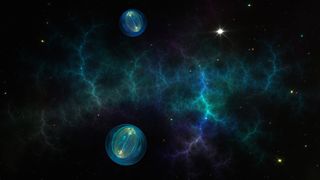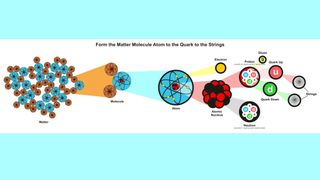
What is the smallest particle in the universe? (What about the largest?)
The smallest weighs way less than an electron.

The universe is a big place, but it's made out of small pieces. The periodic table includes elements such as oxygen, carbon and other building blocks that make up stars, cats or cups of coffee. But since the turn of the 20th century, scientists have been thinking about and finding smaller and smaller fundamental particles — those tinier than atoms that fill up the universe. So which of these fundamental particles is the smallest? And, conversely, which is the largest?
Don Lincoln, a senior scientist at Fermi National Accelerator Laboratory (Fermilab), near Chicago, is one of the scientists trying to answer this question. At Fermilab, scientists use a particle accelerator to smash individual particles together and look at the debris — or possible new fundamental particles — that come out. Lincoln said there are two ways to measure the size of particles: investigating their mass and measuring their physical size, like calculating the diameter of a ball.
Related: How do you weigh an atom?
In terms of mass, these questions are relatively simple to answer. The lowest nonzero-mass particle we know of is the neutrino, Lincoln said. He pointed out, however, that we don't have the exact measurement of a neutrino's mass because the instruments used to calculate mass of fundamental particles aren't sensitive enough.
"A neutrino is a particle, sort of the ghost of the subatomic world," Lincoln said. Neutrinos interact very weakly with matter and are the second most abundant particle after photons (which behave more like waves than actual particles). In fact, there are trillions of neutrinos passing through you at this very second. Neutrinos weigh nearly nothing and travel close to the speed of light.
An atomic nucleus is made up of neutrons, protons and electrons. Protons and neutrons themselves are about one-tenth the size of the nucleus as a whole, Lincoln said. An electron has near-zero mass, but it actually weighs 500,000 times more than a neutrino (again, whose exact measurement is impossible to make at this point).

Physicists use electron volts (eV) to measure the mass of subatomic particles, Lincoln said. Technically, the unit is eV/c^2, in which c is the speed of light. One electron volt is equivalent to about 1.6x10^-19 joules. To simplify things, physicists use a set of units whereby the speed of light is 1. To figure out the mass of a subatomic particle, then, you'd use Albert Einstein's famous equation E=mc^2 to get the mass (m) in kilograms.
Sign up for the Live Science daily newsletter now
Get the world’s most fascinating discoveries delivered straight to your inbox.
An electron weighs 511,000 electron volts, which is equivalent to 9.11 x 10^-31 kilograms, according to Lincoln. For comparison, a typical proton in the nucleus of a typical atom weighs 938 million electron volts, or 1.67 × 10^-27 kg, he said.
Conversely, the largest (in terms of mass) fundamental particle we know of is a particle called a top quark, measuring a whopping 172.5 billion electron volts, according to Lincoln. Quarks are another fundamental particle that, as far as we know, cannot be broken down into more parts. Scientists have found six types of quarks: up, down, strange, charm, bottom and top. Up and down quarks make up protons and neutrons, and they weigh 3 million and 5 million electron volts, respectively. In comparison, the top quark weighs 57,500 times more than the up quark.
The question of physical size is harder to answer. We know the physical size of some particles, but not the smallest ones. Some "tiny" particles that people hear about in daily life, such as virus particles, are actually quite large.
Lincoln offered this sense of scale: A typical virus particle is about 250 to 400 nanometers long (a nanometer is a billionth of a meter, or 10^-9 m), and the typical atomic nucleus measures about 10^-14 m (0.00000000000001 m). That means an atomic nucleus is as small to a virus as a virus is to us.
Currently, the smallest physical size scientists can measure with a particle accelerator is 2,000 times smaller than a proton, or 5 x 10^-20 m. So far, scientists have been able to determine that quarks are smaller than that, but not by how much.
Originally published on Live Science.

JoAnna Wendel is a freelance science writer living in Portland, Oregon. She mainly covers Earth and planetary science but also loves the ocean, invertebrates, lichen and moss. JoAnna's work has appeared in Eos, Smithsonian Magazine, Knowable Magazine, Popular Science and more. JoAnna is also a science cartoonist and has published comics with Gizmodo, NASA, Science News for Students and more. She graduated from the University of Oregon with a degree in general sciences because she couldn't decide on her favorite area of science. In her spare time, JoAnna likes to hike, read, paint, do crossword puzzles and hang out with her cat, Pancake.
Most Popular


